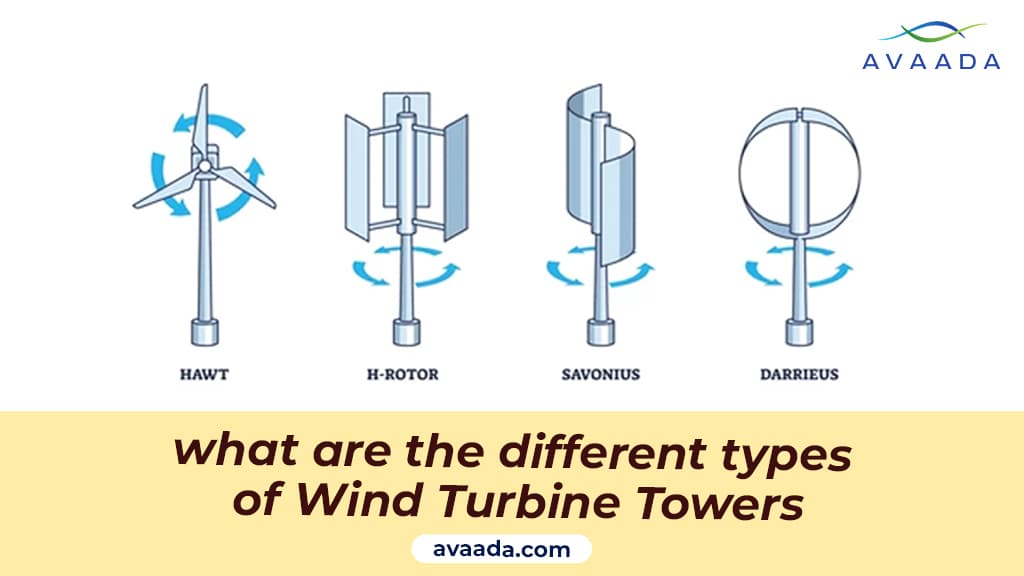Wind turbine towers play a crucial part of the wind turbine, as it supports the nacelle and the rotor blades at a height that optimizes wind capture. Towers have a significant influence on efficiency, cost, and life expectancy of the wind energy project. There are many different types of wind turbine towers which possess unique qualities suited for particular applications and environments. This blog discusses the diverse types of wind turbine towers.
Tubular Steel Towers
The most common type of wind turbine tower. The tubular shape is conical in design, and the wind turbine tower is wider at the bottom and narrower at the top. It is made from rolled steel sections welded together to form the shape.
Advantages:
- Strong and durable: The conical structure provides excellent structural strength and allows the tower to withstand the forces generated by strong winds and the weight of the nacelle and rotor of the turbine.
- Easy installation: The segments are transported to the site in parts, thus making their assembly easier
- Scalability: They can be constructed to suit all turbine sizes
Challenges:
- Heavy weight: The transportation of steel sections is costly and tends to be difficult, especially in areas that are remote.
- Corrosion risk: Additional coatings to the steel are required in cases of coastal surroundings to prevent rusting.
Learn about the lifespan and durability of wind turbines in our guide.
Lattice Towers
They are constructed from steel sections that shape into a lattice structure similar to that of an electrical transmission tower. It was mainly used in the early stages of developing wind energy, but has now become largely a superseded design used for modern massive wind turbines.
Advantages:
- Less weight: Lattice towers weigh less than tubular steel towers, so transportation costs are somewhat lesser.
- Less material: lesser material is used in the making of lattice towers, hence it’s relatively less expensive compared to Tubular steel towers.
- Accessibility for maintenance: The lattice structure ensures accessibility and visibility making it easier to maintain the tower structure.
Challenges:
- Hard to assemble: The structure is complex and more labor-intensive to construct than tubular towers
- Produces more noise: Due to the wind passing through the framework, lattice structures may make more noise
Concrete Towers
Concrete towers are typically used for the larger wind turbines whereas steel towers would be impractical due to weight and transportation constraints. They are assembled from factory-produced concrete sections, which are bolted together on-site in a vertical column.
Advantages:
- High load-capacity: Concrete towers can support extremely large turbines and take large forces due to the wind.
- Resistant to corrosion: They resist corrosion, making them suitable for coastal or offshore installations.
- Locally fabricated: Concrete is typically locally fabricated, which saves transportation cost and engages local economies as well.
Challenges:
- Installation time: The construction takes time
- Cost variability: Cost of concrete differs from place to place, which also adds up to the total cost of the project.
Explore the Wind Energy Potential of India and its impact on sustainable power generation
Hybrid Towers
Hybrid towers combine both the advantages offered by concrete and steel structures. These towers typically have a concrete base with a tubular steel upper section, which helps to reduce the total weight while maintaining structural integrity.
Advantages:
- Optimized design: The use of these two materials facilitates better weight distribution along with enhanced stability.
- Cost-effective: Hybrid towers can minimize the cost of steel while providing for large-sized turbines.
- Suitability for tall turbines: They are highly suitable for extremely tall wind turbines because a concrete base provides a sound foundation.
Challenges:
- Transport logistics: The weight control through hybridization makes transportation not a problem; the concrete sections, however, are hard to move.
Guyed pole
Supported by guyed steel cables anchored into the ground at several points for stability. This construction is mainly used for smaller turbines and is only sometimes used in commercial applications.
Advantages:
Less material usage: They require less material compared to any other type of tower and are cheaper.
Easy installation: The light nature of this tower enables easy transportation and installation.
Remote area suitability: Suitable for locations that have hard ground transportation of large components.
Challenges:
- Guyed pole towers do not apply to the configuration of large turbines because stability is a problem with large turbines.
- The stability test of guy cables requires regular inspection and perpetual upkeep.
- Land space is required for anchoring on all sides of the tower for guy cables.
Offshore wind turbine towers
Are special structures that can withstand a much harsher marine environment. The offshore wind turbine towers are mainly made of steel and offer additional corrosion protection. There are three types of offshore towers: monopile, jacket, and floating foundation.
- Monopile towers are made from a single large steel pipe mounted into the seabed.
- Jacket towers have a lattice framework that offers extra stability in deeper water.
- Floating towers are erected at water levels very deep where fixed foundations cannot be done.








